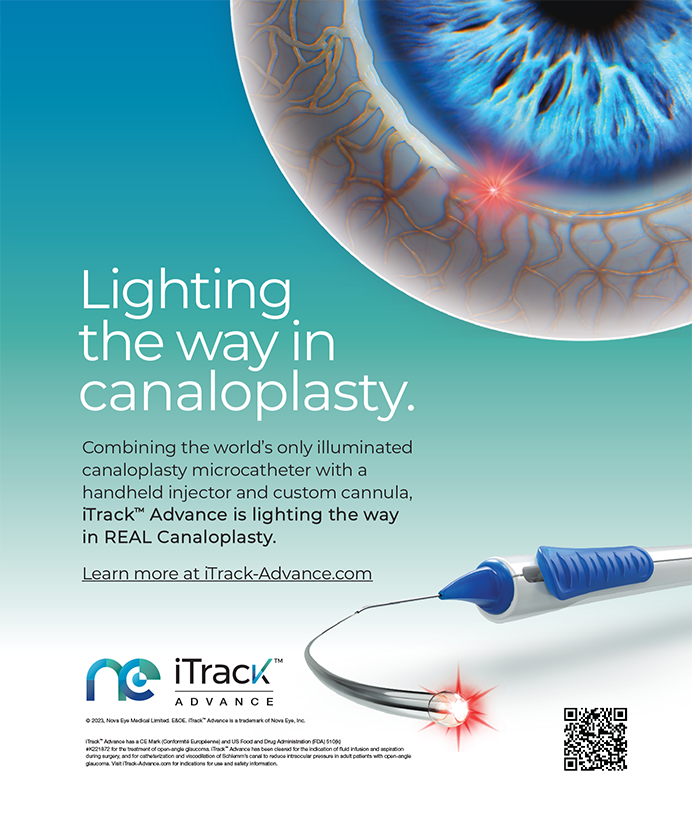Eyetube.net continues to be a repository for videos that showcase the latest surgical techniques in cataract, refractive, glaucoma, and retinal surgery. Recently on Eyetube.net, several surgeons shared their experiences performing cataract surgery with the LenSx Laser (Alcon Laboratories, Inc.). This installment of “Inside Eyetube.net” offers surgical demonstrations of astigmatic treatment and the implantation of IOLs. Equally worthy of attention is a comprehensive course by Lisa Brothers Arbisser, MD, on how to manage complications that arise during the various steps of the cataract procedure.
SURGICAL PROTOCOLS
Astigmatism
Eric Donnenfeld, MD, and Allon Barsam, MD, perform laser cataract surgery with the LenSx Laser and create arcuate incisions to correct astigmatism (Figure 1). They demonstrate how to select the necessary parameters for the laser to create limbal relaxing incisions at a precise depth. Drs. Donnenfeld and Barsam also show how to open the limbal relaxing incisions with surgical calipers.
Implantation of IOLs
In a video from the live surgery session at the 2011 annual meeting of the AAO, Richard Mackool, MD, and Richard J. Mackool Jr, MD, performed cataract surgery with the LenSx Laser on a 58-year-old woman with a 2+ anterior capsular cataract, a 2+ nuclear sclerotic cataract, and a 1+ posterior subcapsular cataract in her left eye. The patient's cornea was normal, with a central corneal thickness of 558 μm. The lens was 4.49-mm thick. The axial length was 24.69 mm, and the keratometry reading was 42.38 D @ 23º X 43.04 D @ 113º. Drs. Mackool broke the cataract into four quadrants, and they created a 4.5-mm capsulotomy with the laser (Figure 2). After the laser portion of the surgery, the surgeons implanted an AcrySof IQ Restor IOL +3.0 D (model SN6AD1; Alcon Laboratories, Inc.).
In another video from the live surgery session, Kerry Solomon, MD, performed cataract surgery with the LenSx Laser and implanted an AcrySof IQ Toric IOL (Alcon Laboratories, Inc.) in a 65-year-old woman with a 2+ nuclear sclerotic cataract and a 2+ posterior subcapsular cataract in her left eye. The cornea was normal, with a central thickness of 551 μm. The lens was 4.29-mm thick. The axial length was 23.41 mm, and the keratometry reading was 42.03 D @ 174º X 43.55 D @ 84º. Dr. Solomon created a 5-mm capsulotomy with the LenSx Laser. He broke the nucleus with a 4.9-mm cruciate and 2.5-mm cylindrical pattern (Figure 3).
CLINICAL COURSE ON MANAGING COMPLICATIONS
Dr. Arbisser provides a comprehensive course on the steps surgeons can take when they encounter complications during cataract surgery. In this series of 18 video vignettes, Dr. Arbisser discusses her own clinical experience and laboratory work, and she offers solutions for how to close a wound, how to perform a vitrectomy, how to manage fragments from a dropped nucleus, and much more. Her videos demonstrate techniques for limiting further complications when extra steps are needed.
CONCLUSION
Cataract surgery remains an evolving art. These videos provide an opportunity for cataract surgeons to watch, learn, and adopt new protocols to improve outcomes with femtosecond lasers. As alluring as new technology can be, it is important to be mindful that new, unfamiliar complications may arise. When this happens, ophthalmologists need to return to those first, basic surgical steps that they learned as residents and recognize when it is time to put down the phaco probe and perform a vitrectomy instead. As amazing as femotsecond lasers may become, cataract surgery will remain a highly challenging, 15-minute, elective procedure.
Section Editor Elena Albé, MD, is a consultant in the Department of Ophthalmology, Cornea Service, Istituto Clinico Humanitas Ophthalmology Clinic, Milan, Italy.
Section Editor Mark Kontos, MD, is the senior partner at Empire Eye Physicians in Spokane, Washington.
Section Editor Damien F. Goldberg, MD, is in private practice at Wolstan & Goldberg Eye Associates in Torrance, California. He is a consultant to Alcon Laboratories, Inc., but acknowledges no financial interest in the products mentioned herein. Dr. Goldberg may be reached at (310) 543-2611; damien.goldberg@wolstaneye.com.


